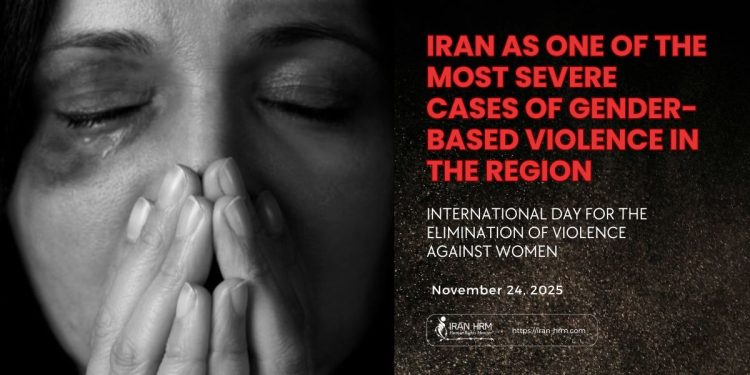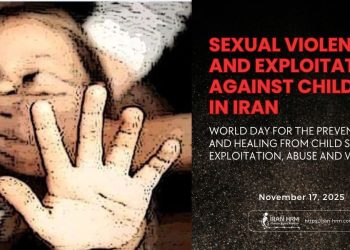As the International Day for the Elimination of Violence Against Women approaches, data from recent years shows that violence against women and girls in Iran has reached unprecedented levels.
Background of the International Day for the Elimination of Violence Against Women
The International Day for the Elimination of Violence Against Women, marked on November 25, commemorates the Mirabal sisters — political activists from the Dominican Republic who were assassinated in 1960 under the dictatorship of Rafael Trujillo. In 1999, the United Nations designated this date as the launch of the global “16 Days of Activism Against Gender-Based Violence,” emphasizing the responsibility of governments to prevent violence, protect victims, and ensure accountability.
Comparison With the Situation in Iran
While many countries have strengthened legal protections and support systems for women over recent decades, Iran has moved in the opposite direction. Discriminatory laws, deadly street violence, femicide, medical deprivation in prisons, and the repression of female protesters indicate that the ruling regime in Iran is not only failing to meet its international obligations but is itself the primary producer and enforcer of systemic violence against women.
1. Legal Violence: A Structure That Reproduces Abuse
Documented Case
In 2023, a 13-year-old girl forced into marriage with the approval of her father and a judge became pregnant after fleeing to a shelter, where she received no meaningful legal or medical protection.
Analytical Review
Iran’s legal system lacks mechanisms to prevent violence against women and provides no real protection for victims. Instead, the laws reinforce and legitimize violence.
1.1 Thirteen Years of Delay and Dilution of the Anti-Violence Bill
The bill, first introduced in 2010, has undergone significant weakening, removal of protections, and repeated alterations — and remains unpassed.
Notably:
The latest version of the bill does not contain the word “violence” even once.
1.2 Legalization of Violence in Statutory Text
– Emphasis on “male authority over the family”
– Maintaining open pathways for child marriage (Article 1041 of the Civil Code)
– Reduced penalties for fathers, husbands, or male guardians who commit violence
– Women’s testimony being legally valued at half that of men
1.3 Lack of Legal Protection in Domestic Violence
– Police frequently refuse to intervene in domestic abuse
– Support centers often urge women to “return home”
– Divorce is made extremely difficult for women
– Custody of children over age seven is taken from mothers
2. Judicial and Penal Violence: Systematic Repression of Female Protesters and Prisoners
Documented Case
In 2023, a 29-year-old woman was sentenced to a long prison term solely for posting a short protest message on social media, without access to an independent lawyer and following interrogations involving threats.
Analytical Review
The judicial apparatus is a central tool of state repression against women:
– Security-related fabricated charges
– Closed-door trials
– Harsh sentences without due process
– Threats against families
– Denial of independent legal counsel
2.1 Women Prisoners: A Unified Pattern of Torture, Deprivation, and Systematic Abuse
Female political prisoners — including Zeinab Jalalian, Maryam Akbari Monfared, Golrokh Iraee, and Shiva Esmaeili — have been subjected to a consistent pattern of abuse:
– Long-term or life sentences without leave
– Total denial of medical care, even after major surgeries
– Immediate return to prison following surgical procedures
– Prolonged solitary confinement
– Punitive transfers
– No access to calls, visits, or books
– New fabricated charges inside prison
– Severe psychological pressure on children of prisoners (e.g., the child of Shiva Esmaeili)
– Continuous threats, humiliation, and psychological torture
Executions of Women
In 2025 alone, 53 women have been executed, placing Iran among the countries with the highest number of female executions.
3. Security and Street Violence: Control of Women’s Bodies and Physical Elimination
Documented Cases
– Mahsa (Jina) Amini — died after being detained and beaten for her clothing.
– Armita Geravand — collapsed after an encounter with morality-enforcement agents and died under security control.
– During the 2022 protests, girls including Nika Shakarami, Sarina Esmaeilzadeh, and Hadis Najafi were killed by security forces.
Analytical Review
Security violence includes:
– Arrests without warrants
– Beatings and lethal force
– Forced confessions
– Humiliation in detention
– Online harassment
– Control over women’s bodies and appearance
4. Domestic and Sexual Violence: Widespread, Hidden, and Unaddressed
Documented Case
In the first half of 2024, 15,764 women were recorded as victims of spousal abuse; more than 150 women were killed by male relatives.
Analytical Review
– Marital rape is not criminalized
– Only 17 shelters exist nationwide
– Honor killings are increasing
– Police refusal to intervene
5. Socio-Economic Violence: Poverty, Exclusion, and Structural Discrimination
Documented Case
Women heads of households report being denied employment solely due to gender.
Analytical Review
– Wage inequality
– Hiring discrimination
– Widespread poverty
– Exclusion from management
– Lack of social support
6. Violence Against Girls and Adolescents: A Generation Under Pressure
Documented Case
Dozens of schoolgirls arrested and mass poisoning incidents in girls’ schools in 2023–2024.
Analytical Review
– Arrest of minors
– Child marriage under age 15
– Barriers to education
– Family intimidation
– Long-term psychological harm
Conclusion
Violence against women in Iran is multilayered, systemic, and embedded in the governing structure. From streets to prisons, homes to workplaces, young girls to political prisoners, a unified pattern of gender-based repression is evident.
UN, OHCHR, UN Women, EU, and Amnesty International have condemned violence against women in Iran.
International Call to Action
- Launch independent investigations
- Release all female political prisoners
- Pressure Iran to comply with obligations
- Activate accountability mechanisms
- Protect victims’ voices







